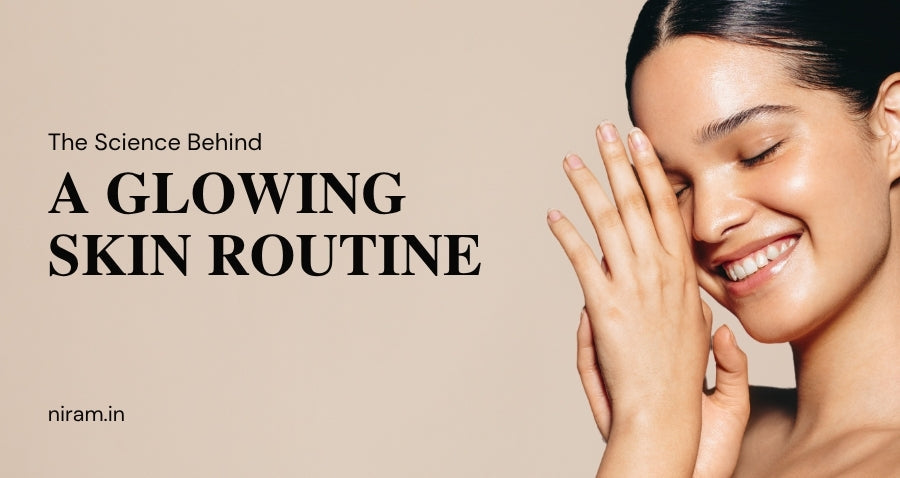We all dream of naturally glowing, radiant skin. But achieving that glow isn’t just about using the latest trending product — it’s about understanding the science behind how your skin works and what it truly needs every day. At Niram.in, we believe beauty begins with balance — balancing skincare science with self-care.
Let’s explore how you can unlock your skin’s natural glow with a routine that works from the inside out.
💧 1. Cleansing – The Foundation of Glow
Your skin collects dirt, sweat, oil, and pollutants throughout the day. These impurities can clog pores and make your skin look dull.
A gentle cleanser removes the build-up without stripping your skin’s natural oils.
Science tip:
Your skin’s pH level should ideally be around 5.5. Using a pH-balanced cleanser helps maintain the protective acid mantle — the barrier that keeps bacteria and toxins out.
🪄 Niram Recommends: Choose sulfate-free, mild cleansers suitable for your skin type — dry, oily, or combination.
🌿 2. Exfoliation – Boosting Cell Renewal
Dead skin cells can pile up, blocking light reflection and leading to a tired look. Exfoliation helps reveal fresh, smooth skin beneath.
Science fact: The skin naturally renews itself every 28 days, but this process slows with age and stress. Gentle exfoliation (1–2 times per week) supports this renewal process.
There are two types:
-
Physical exfoliants: scrubs or polishes
-
Chemical exfoliants: AHAs (like glycolic acid) and BHAs (like salicylic acid)
🪄 Niram Recommends: Use a mild exfoliator enriched with fruit enzymes or natural beads — never harsh scrubs!
🌞 3. Moisturizing – Locking in Hydration
Hydration is the key to plump, radiant skin.
When your skin loses moisture, it looks dry, flaky, and dull. Moisturizers create a protective barrier that prevents water loss and keeps your skin soft and glowing.
- Science tip: Look for humectants like hyaluronic acid, which attract water molecules, and emollients like shea butter or ceramides that seal in moisture.
🪄 Niram Recommends: Apply moisturizer right after washing your face to trap hydration effectively.
☀️ 4. Sun Protection – The Glow Preserver
No matter how great your routine is, skipping sunscreen can undo everything. UV rays damage collagen, cause pigmentation, and lead to premature ageing.
-
Science fact: Up to 80% of visible skin ageing is caused by sun exposure.
SPF acts as a shield, preventing damage and helping maintain even-toned, glowing skin.
🪄 Niram Recommends: Use a broad-spectrum SPF 30 or higher, even on cloudy days.
🥗 5. Nutrition and Hydration – Glow from Within
Your skin reflects what’s happening inside your body.
A balanced diet rich in vitamin C, E, omega-3 fatty acids, and antioxidants helps repair cells and fight oxidative stress.
Science tip:
-
Drink at least 8 glasses of water a day.
-
Add colourful fruits, leafy greens, and nuts to your diet.
🪄 Niram Recommends: Start your morning with warm water and lemon to boost hydration and detoxification.
🌙 6. Consistency is Everything
Healthy skin isn’t built overnight — it’s the result of consistent care.
Following your morning and night skincare routine daily helps your skin adapt, heal, and maintain balance naturally.
🪄 Niram Tip: Be patient! Give every product at least 3–4 weeks to show real results.
🌼 Final Thoughts
Glowing skin is more than just surface-level beauty — it’s a reflection of healthy habits, mindful care, and scientific understanding.
At Niram.in, we blend traditional wisdom with modern skincare science to help you achieve your healthiest, most radiant skin yet.
Remember: Glow is a process, not a product.
✨ Explore Niram’s curated skin and hair care range
Find your perfect daily essentials at 👉 www.niram.in
⚠️ Disclaimer
The information provided in this blog is for educational and informational purposes only. It is not intended to diagnose, treat, cure, or prevent any skin condition.
Always consult a dermatologist or skincare professional before introducing new products or treatments, especially if you have sensitive skin, allergies, or medical conditions.
Results may vary based on individual skin types and lifestyle factors.

